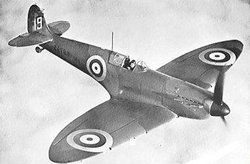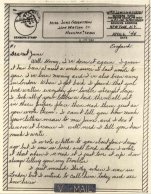Glossary
ADM. I was unable to find out exactly what words these letters stand for, but some aviation experts I consulted confirmed that it is a kind of radio beacon used in navigation. It was mentioned in the Journal in connection with Billy's eighth mission, when he was having some difficulty finding the way back to the home base in England.
Air Medal. This decoration was awarded after five missions, and was augmented with Oak Leaf Clusters (see below) when an airman had accomplished multiples of five missions. As the citation on the official order awarding Billy his Air Medal states, he was:
cited for meritorious achievement while participating in 5 separate bombardment missions over enemy occupied terriory, where enemy antiaircraft fire experienced and exposure to attack by enemy fighter airplanes involved great personal danger to all members of the crew.
I retrieved the image at the right is from Grunt's website, which appears no longer active. Wikipedia has information and images here. |
|
APO. Army Post Office. When soldiers are overseas mail gets to them via A.P.O., rather than to an address where they actually are. This allows correspondents to use domestic postage, keeps the location of the soldiers a secret, and also enables mail to catch up with them as they change locations.
B-17s. These large bombers, nicknamed the "Flying Fortresses," were referred to by Billy as "our big brothers, the Forts." His friend Lard (Shirley Estes) flew one. They had a longer range than the Marauders and were thus used for missions over Germany, even very early in the war. The picture at the right is from the Library of Congress'Centennial of Flight website, which appears to be inactive currently.

The one below is from another website, Aircraft of World War II. This link leads to an index of aircraft images on the site. |
|
|
B-26 Marauder. The medium bomber on which Billy served as Navigator, and sometimes Bombardier. It had a somewhat controversial history within the Army Air Forces. And at the end of the war the remaining planes (except for the one in the
Smithsonian Air and Space Museum and a few others) were destroyed. But they compiled an admirable service record in the area of tactical missions, often in direct support of ground troop operations.
The B-26 crews consisted of a pilot, co-pilot (sometimes not present), navigator, bombardier (sometimes these two were combined), a tail gunner, an engineer/gunner and a radio operator/gunner. Over 5,000 of the planes were built by the Glenn L. Martin Company and they were flown, primarily over Europe, from April, 1942 until May, 1945.
|
 |
| Balloon barrages. Arrays of large balloons tethered to the ground whose purpose was to deny low-level airspace to enemy aircraft. The balloons were used in England in World War I and II, and were also used in the U.S. during the latter conflict when invasion was feared early in the war.
|
|
The picture at the left shows a barrage balloon (Billy flipped the terminology in his Journal, saying "balloon barrage" instead of "barrage balloon"; presumably this is how the Yank fliers referred to them) over the Tower Bridge in London (one of the balloons Billy and his pilot were worried about encountering during his fourth mission). The picture comes from the website
"Barrage Balloons in World War II" where there are more pictures and much more information, especially about the production and use of the balloons in the U.S.
The following is from the website:
"It was hoped that the barrage balloons would deter invasion by low-flying aircraft. The barrage balloon, filled with lighter-than-air gas, was attached to a steel cable that could be raised or lowered.... The cables themselves presented a hazard to pilots, capable of shearing off a passing plane's wings and propeller. ... By the middle of 1940, there were 1,400 balloons, a third of them over the London area. By 1944 the number had risen to nearly 3,000. Later in the war, the barrage balloons were moved to combat the V-1 'flying bomb.' ...
The balloons were huge (on average, about 62 feet long and 25 feet in diameter)..."
|
Battle Stars. If soldiers participate in a particular campaign they are eligible to wear a star representing that campaign on the ribbon representing that theatre of operations. For example, Billy
certified that he was eligible to wear three Battle Stars on his European Theatre ribbon: one for the European Air Offensive, one for Normandy, and one for Northern France.
BOQ. Bachelor Officers' Quarters.
Box. A group of bombers flying in formation. According to the 381st Bomb Group's website*: " Combat formations were normally flown ... with three squadrons of six ships each: one lead, one low on the left, and one high on the right. ... the conventional six-ship box consist[ed] of two elements of three ships each." Billy also uses the word "box" to describe a grouping of three six-ship smaller formations, as you can see in the diagram on the right, from the Journal:
*Although the 381st Group consisted of "heavy" bombers, the terminology for formations was more or less the same for the medium bombers like the B-26 Marauders. The website where I found the text above is currently inactive, but I have updated the link to one that looks like its descendnat.
|
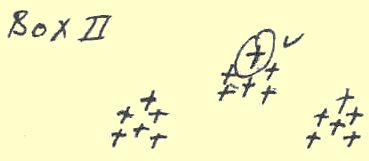 |
[Back to top]
CAA. Civil Aviation Authority.
C in C. Commander in Chief.
CO. Commanding Officer
| DFC. Distinguished Flying Cross, the medal awarded after an airman's 25th mission, and for other distinguished service. The image of the medal below is from the
DFC Society's website, where you can find much more information about the medal. Wikipedia also offers images and information here. |
At the far right is a photo of Billy receiving his D.F.C., at some time following his 25th mission, which was flown in January of 1944. The officer pinning the medal on him is Col. Richard T. Coiner, Jr., of San Antonio, according to a typed caption on the reverse of the photo. Col. Coiner was the group commander.
Here is the citation that appeared on the
official order awarding Billy his DFC, dated February 12, 1944:
1st Lt. William D. Lewis is cited for extraordinary achievement while serving as a bombardier-navigator on a B-26 airplane on 25 bombardment missions over enemy occupied Continental Europe. Lt. Lewis participated in many missions dispatched against heavily defended enemy positions under the most hazardous conditions. His technical skill and undaunted courage have marked his work on these missions and have played a major role in their successful completion. The services of Lt. Lewis reflect great credit upon himself and the Army Air Force.
|
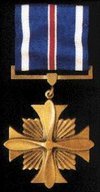

|
 |
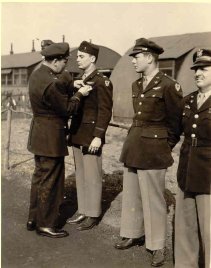 |
DR. Abbreviation for "Dead reckoning," which simply means calculating an object's position based on the distance it traveled in its current direction from its previous position, using math rather than electronic or other types of navigation equipment.
DS. Detached service, or temporary duty. As Billy explains in a
letter to June, when "you are sent to another outfit which isn't your own for duty for a period of time, you are said to be on detached service and in most cases it is a good deal."
ETA. Estimated time of arrival.
ETO. European Theatre of Operations, where Billy was stationed, in contrast with the Asia/Pacific Theatre. The European Theatre is usually meant to include Africa (Billy mentions this in a
letter explaining the terminology to June) although I did run across some references that had a separate Theatre listed for the Mediterranean, which included Italy and north Africa.
| GEE. A type of radio navigation that "used a series of broadcasters sending out precisely timed signals, and the aircraft using GEE ... examined the time of arrival on an oscilloscope at the navigator's station. If the signal from two stations arrived at the same time, the aircraft must be an equal distance from both, allowing the navigator to draw a line on his map of all the positions at that distance from both stations. By making similar measurements with other stations additional lines can be produced, leading to a fix. GEE was accurate to about 165 yards (150m) at short ranges, and up to a mile (1.6km) at longer ranges over Germany." The name came from the first letter of "grid." (This information is from the Wikipedia's article on Radio navigation.) |
| |
Above is a picture of the GEE apparatus, from the website of Norman Groom, a hobbyist connected with Pitstone Museum in England and the Duxford Radio Society at the Imperial War Museum in Duxford, England. (More information and pictures of GEE equipment can be found at their
website; and to see some photos of the Museum that we took on our 2008 visit, click here.)
At the right is a page from Billy's small notebook with a list of airmen's names. The figures opposite each name may refer to the amount of training time spent with the GEE equipment.
|
| Havoc. An attack bomber, manufactured by Douglas, with the numerical designation A-20. The picture of the Havoc at right is from the
U.S. Air Force Museum. |
 |
IP. Initial Point (point of reference for navigation during a mission).
| Liberator. Also known as the B-24, this large 4-engine bomber was manufactured by Consolidated. The picture at right is from the
Acepilots.com website. Billy quotes a statement by his Group Commander, Wilson R. Wood, before the D-Day invasion, that "in the target area this morning there will be some 1500 Forts and Liberators...."
|
|
[Back to top]
| ME 210. (ME stands for Messerschmidt) This German fighter that Billy saw at "close range" during his 25th mission was described by the Fighter Aircraft and Aces of World War II website (the website is no longer active, but Wikipedia has images and information here) as "a disaster and one of the worse aircraft to see mainstream production during World War II." This picture of one of the 210 varieties is from the
Wings Palette website. |
 |
| Mosquito. A small (twin-seater) fighter/bomber manufactured by the British De Haviland company. The picture of the Mosquito below is from the British Aircraft of World War II website, which is no longer active. However, Wikipedia offers images and information here. |
 . |
No Balls (X targets). See this information page about the No Ball targets.
 |
Oak Leaf Clusters. Small decorations added to the ribbon representing a certain medal instead of awarding the medal multiple times. For example, Billy earned an Air Medal (see above) after five missions. For each subsequent five missions, he earned an "oak leaf cluster" to wear on the medal ribbon. Although his Qualification Record states that he won 11 OLC's, it should have been twelve, given that he flew 66 missions. And June always told us that it was 12. (His headstone, provided by the Air Force, is further off, numerically, saying he only had 2, but that is only one digit off from 12.) Perhaps there was some bookkeeping confusion somewhere in the Air Force's records. On the left is an image from Wikipedia that shows what the 12-OLC ribbon looks like.
Bronze and silver OLCs (there are two silver and two bronze pins on this ribbon) indicate different levels of accomplishment. Silvers count as 5 bronzes. Billy was awarded a silver oak leaf cluster "in lieu of the 10th bronze Oak Leaf Cluster," according to the
official order awarding him this decoration, which was dated September 28, 1944. |
P-38. This plane, built by Lockheed, was a twin-engine single-seat fighter that saw extensive action in World War II. It was one of Billy's favorite planes, as evidenced by his calling it the "prettiest airplane ever built" in his write-up of mission 43. There is also a poem called "P-38" which appears in the Journal before Billy even enlisted. It is unclear whether he wrote it himself or copied it from somewhere else—no credits are given with it.
The picture of the P-38 at the right is from the
website of the National Air and Space Museum in Washington, where you can find more information about the aircraft. |
 |
| P-51. A widely-used fighter both in Europe and in the Pacific (my husband's father, Col. Henry J. Amen, Jr., flew a P-51 in China). Billy describes a P-51 "giving [a flak battery] Hell with its guns" during the D-Day mission. According to the
National Air Force Museum website, where the picture at right was found, "by war's end, P-51s had destroyed 4,950 enemy aircraft in the air, more than any other fighter in Europe."
|
|
OTU. Operational Training Unit.
PFF.(Pathfinder). Advanced navigation equipment utilizing ground-based transmissions and designed to help bomb when targets were concealed by heavy cloud cover. It was first used by Marauders in February of 1944. Moench, p.159-163, devotes an entire chapter to the Pathfinder technology and the special squadron formed in early 1944 to use it. Billy mentions PFF or Pathfinder in conjuction with his 60th and 65th missions.
PDI. Pilot's Directional Indicator. A device used for making course corrections that was coordinated with the bombardier's instruments.
RAF. Royal Air Force. These are the airmen to whom Winston Churchill referred, in his famous remark about their success during the Battle of Britain in the winter of 1940-41: "Never have so many owed so much to so few." They of course worked in close coordination with the American forces after the U.S. joined the war. For some photos I took of the Battle of Britain Memorial in London, click here.
| Spitfires (Spits). A single-seat British fighter that provided protection for many of the Marauder bombing missions, referred to by Billy as the "lovely Spits." The picture at right is from the Nationmaster.com Encyclopedia; there are more images and information at Wikipedia. |
|
| V-mail. A special way of sending mail to and from soldiers. At right is a sample of a piece of v-mail. To learn more, and to see images of the v-mails Billy sent June, click here.
|
|
Window. The codename for a simple system of countermeasures intended to confuse German radar. It consisted of "packets of aluminium strips from aircraft to generate a cloud of false echoes," according to Wikipedia, whose article includes information on this technique plus more efforts to fool radar and other surveillance.
[Back to top]

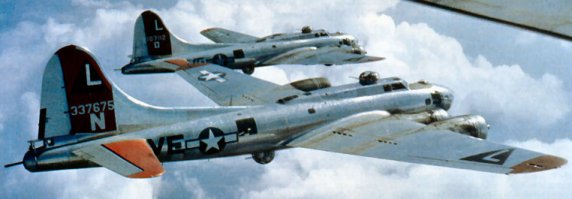





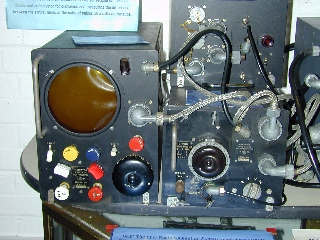
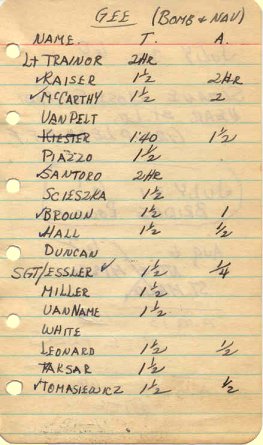

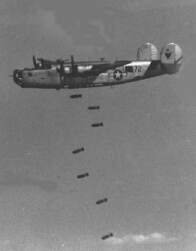

 .
. 
